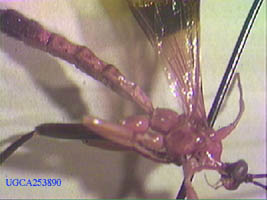Pimplinae
Index
|
 |
Natural History
The subfamily Pimplinae is the most biologically diverse subfamily of the
Ichneumonidae family. It is associated with a very wide range of hosts. Pimplinae
includes three tribes: Ephialtini, Pimplini, and Polysphinctini.
All members of the subfamily are generalist parasites. The
species of the most primitive tribe, the Ephialtini, are idiobiont ectoparasitoids of
larvae, pupa, or prepupa often consealed in plant tissue.
Some species within the tribe Pimplini are also idiobiont ectoparasitoids, while
others of this tribe are idiobiont endoparasitoids, commonly of Lepidoptera prepupae and pupae.
The tribe Polysphinctini generally contains species that are koinobiont ectoparasitoids
and parasitise Araneae exclusively. Unlike members of Ephialtini and Pimplini, the members
of Polysphinctini allow for further development of its host after oviposition (Nielsen,1923;28;29;35;37).
Most adult Pimplinae feed on honeydew, nektar and other plant secretions (Leius,1960; Cole,1967 cited by Gauld, 1991)(Juillet,1959).
Female pimplines require a protein-rich source of nutrition for the production of eggs. They are
known to feed on individuals of their hosts to fullfill this requirement. These individuals are
not commonly used for oviposition.(Gauld,I. p.142-146)
New World Genera
- Scampus
- Calliephiales
- Anastelgis
- Dolichomitus
- Leptopimpla
- Umanella
- Iseropus
- Clydonium
- Odontopimpla
- Zonopimpla
- Tromatobia
- Zaglyptus
- Clistopyga
- Dreisbachia
- Polysphincta
- Acrotaphus
- Hymenoepimecis
- Ticapimpla
- Eruga
- Flacopimpla
- Zatypoga
- Nomosphecia
- Neotheronia
- Xanthopimpla
- Apechthis
- Itoplectis
- Pimpla
- Exeristes
- Liotryphon
- Townesia
- Dolichomitus
- Acropimpla
- Gregopimpla
- Alophasternum
- Schizopyga
- Zabrachypus
- Acrodactyla
- Colpomeria
- Piogaster
- Oxyrrhexis
- Sinarachron
- Ephialtes
- Coccugomimus
- Theronia
- Neotheronia
- Perithous
- Delomerista
- Pseudorhyssa
- Diacritus
- Poemenia
- Podoschistus
- Neoxorides
The indentification guide is currently under construction. Sorry for any inconviences.
The photograph gallery is currently under construction.
Burks, B.D., Paul D. Hurd, Jr., Karl V. Krombein, and David P. Smith. 1979. Catalog of Hymenoptera in America North of Mexico. Smithsonian Institution Press.Washington D.C.
Gauld, Ian. Ichneumonidae of Costa Rica,1) n47. Memoirs of the American Entomological
Institute, Florida.
Acknowledgements
Thanks to the members of Dr. Pickering's lab team
including Dr. Pickering, Ryan, Elizabeth, Brian, Jessica and others
who helped with information and the develpment of this page.

